Heavy Mineral Assemblage Variation in Late Cenozoic Sediments from the Middle Yangtze River Basin: Insights into Basin Sediment Provenance and Evolution of the Three Gorges Valley
Abstract
:1. Introduction
2. The Yangtze River Basin
2.1. River Setting
2.2. The Jianghan Basin
2.3. The Late Cenozoic Zhoulao Drillcore
3. Sampling and Method
4. Analysis and Results
4.1. Heavy Mineral Species and Heavy Mineral Concentration Index
4.2. Heavy Mineral Assemblages
4.3. Apatite–Tourmaline, Garnet–Zircon, and Zircon–Tourmaline–Rutile Index Analysis
5. Discussion
5.1. Provenance of Diagnostic Heavy Minerals
5.2. Comparison of Heavy Metals with Other Provenance Indicators for the Zhoulao Core
5.3. Implications for the Timing of Incision of the Three Gorges
6. Conclusions
Author Contributions
Funding
Data Availability Statement
Conflicts of Interest
References
- Chen, Z.; Li, J.; Shen, H.; Zhanghua, W. Yangtze River of China: Historical analysis of discharge variability and sediment flux. Geomorphology 2001, 41, 77–91. [Google Scholar] [CrossRef]
- Wu, W. Sediment geochemistry of large rivers originating from the Tibetan Plateau: Provenance and weathering. Quat. Int. 2012, 279–280, 542. [Google Scholar] [CrossRef]
- Wang, K.; Zheng, H.; Tada, R.; Irino, T.; Zheng, Y.; Saito, K.; Karasuda, A. Millennial-scale East Asian Summer Monsoon variability recorded in grain size and provenance of mud belt sediments on the inner shelf of the East China Sea during mid-to late Holocene. Quat. Int. 2014, 349, 79–89. [Google Scholar] [CrossRef]
- Xu, J.; Yang, D.; Yi, Y.; Lei, Z.; Chen, J.; Yang, W. Spatial and temporal variation of runoff in the Yangtze River basin during the past 40 years. Quat. Int. 2008, 186, 32–42. [Google Scholar] [CrossRef]
- Wei, C.; Liu, C.; Li, W.; Zhang, Z.; Zhang, H.; Zhao, J.; Zhang, L. Nature ESR signals of quartz E’center shed new light on river sediments provenance: A case study in southeast margin of the Tibet Plateau. Quat. Int. 2017, 454, 38–44. [Google Scholar] [CrossRef]
- Liu, S.; Mi, B.; Fang, X.; Li, X.; Pan, H.-J.; Chen, M.-T.; Shi, X. A preliminary study of a sediment core drilled from the mud area on the inner shelf of the East China Sea: Implications for paleoclimatic changes during the fast transgression period (13 ka BP–8 ka BP). Quat. Int. 2017, 441, 35–50. [Google Scholar] [CrossRef]
- Li, C.; Yang, S.; Lian, E.; Wang, Q.; Fan, D.; Huang, X. Chemical speciation of iron in sediments from the Changjiang Estuary and East China Sea: Iron cycle and paleoenvironmental implications. Quat. Int. 2017, 452, 116–128. [Google Scholar] [CrossRef]
- Clift, P.D.; Blusztajn, J.; Nguyen, A.D. Large-scale drainage capture and surface uplift in eastern Tibet–SW China before 24 Ma inferred from sediments of the Hanoi Basin, Vietnam. Geophys. Res. Lett. 2006, 33, 33. [Google Scholar] [CrossRef] [Green Version]
- Shao, L.; Yuan, S.; Kang, C.; Wang, J.; Li, T. Neodymium isotopic variations of the late Cenozoic sediments in the Jianghan Basin: Implications for sediment source and evolution of the Yangtze River. J. Asian Earth Sci. 2012, 45, 57–64. [Google Scholar] [CrossRef]
- Zheng, H.; Clift, P.D.; Wang, P.; Tada, R.; Jia, J.; He, M.; Jourdan, F. Pre-miocene birth of the Yangtze River. Proc. Natl. Acad. Sci. USA 2013, 110, 7556–7561. [Google Scholar] [CrossRef] [Green Version]
- Lu, X.; Jiang, T. Larger Asian rivers: Shorter and longer term hydro-climate changes in humid and arid environments. Quat. Int. 2014, 336, 1–5. [Google Scholar] [CrossRef]
- Zhang, Z.; Daly, J.S.; Li, C.A.; Tyrrell, S.; Sun, X.; Yan, Y.J. Sedimentary provenance constraints on drainage evolution models for SE Tibet: Evidence from detrital K-feldspar. Geophys. Res. Lett. 2017, 44, 4064–4073. [Google Scholar] [CrossRef]
- Mao, L.; Mo, D.; Yang, J.; Guo, Y.; Lv, H. Rare earth elements geochemistry in surface floodplain sediments from the Xiangjiang River, middle reach of Changjiang River, China. Quat. Int. 2014, 336, 80–88. [Google Scholar] [CrossRef]
- Bi, L.; Yang, S.; Zhao, Y.; Wang, Z.; Dou, Y.; Li, C.; Zheng, H. Provenance study of the Holocene sediments in the Changjiang (Yangtze River) estuary and inner shelf of the East China sea. Quat. Int. 2017, 441, 147–161. [Google Scholar] [CrossRef]
- Hu, C.; Xu, Y.; Hu, C.; Wu, L.; Xu, G.; Yang, L. Genesis of the Qingyijiang River on the northern fringe of Mt. Huangshan, China, based on a combined analysis of gravel fabrics and ESR dates. Quat. Int. 2017, 440, 137–146. [Google Scholar] [CrossRef]
- Pan, D.; Chen, T.; Zhan, Q.; Wang, Z. Mineral magnetic properties of Holocene sediments in the subaqueous Yangtze delta and the implications for human activity and early diagenesis. Quat. Int. 2017, 459, 133–143. [Google Scholar] [CrossRef]
- Mi, B.; Liu, S.; Shi, X.; Li, X.; Pan, H.-J.; Chen, M.-T.; Wang, X. A high resolution record of rare earth element compositional changes from the mud deposit on the inner shelf of the East China Sea: Implications for paleoenvironmental changes. Quat. Int. 2017, 447, 35–45. [Google Scholar] [CrossRef]
- Gu, J.; Chen, J.; Sun, Q.; Wang, Z.; Wei, Z.; Chen, Z. China’s Yangtze delta: Geochemical fingerprints reflecting river connection to the sea. Geomorphology 2014, 227, 166–173. [Google Scholar] [CrossRef]
- Li, J.; Xie, S.; Kuang, M. Geomorphic evolution of the Yangtze Gorges and the time of their formation. Geomorphology 2001, 41, 125–135. [Google Scholar] [CrossRef]
- Xiang, F.; Zhu, L.; Wang, C.; Zhao, X.; Chen, H.; Yang, W. Quaternary sediment in the Yichang area: Implications for the formation of the Three Gorges of the Yangtze River. Geomorphology 2007, 85, 249–258. [Google Scholar] [CrossRef]
- Zhang, Y.; Wang, Q.; Chen, L.; Ma, Y.; Kang, C. Magnetism parameters characteristics of drilling deposits in Jianghan Plain and indication for forming of the Yangtze River Three Gorges. Chin. Sci. Bull. 2008, 53, 584–590. [Google Scholar] [CrossRef]
- Clark, M.; Schoenbohm, L.; Royden, L.; Whipple, K.; Burchfiel, B.; Zhang, X.; Tang, W.; Wang, E.; Chen, L. Surface uplift, tectonics, and erosion of eastern Tibet from large-scale drainage patterns. Tectonics 2004, 23. [Google Scholar] [CrossRef] [Green Version]
- Clift, P.D.; Long, H.V.; Hinton, R.; Ellam, R.M.; Hannigan, R.; Tan, M.T.; Blusztajn, J.; Duc, N.A. Geophysics, Geosystems, Evolving east Asian river systems reconstructed by trace element and Pb and Nd isotope variations in modern and ancient Red River-Song Hong sediments. Geochem. Geophys. Geosystems 2008, 9. [Google Scholar] [CrossRef]
- Richardson, N.; Densmore, A.; Seward, D.; Wipf, M.; Yong, L. Did incision of the Three Gorges begin in the Eocene? Geology 2010, 38, 551–554. [Google Scholar] [CrossRef] [Green Version]
- Li, F.; Zhu, C.; Wu, L.; Sun, W.; Liu, H.; Chyi, S.-J.; Kung, C.-L.; Zhu, G.; Wang, X. Environmental humidity changes inferred from multi-indicators in the Jianghan Plain, Central China during the last 12,700 years. Quat. Int. 2014, 349, 68–78. [Google Scholar] [CrossRef]
- Wang, J.; Yang, Y.; Shao, L.J. Detrital zircon geochronology and provenance of core sediments in Zhoulao Town, Jianghan plain, China. J. Earth Sci.-China 2010, 21, 257–271. [Google Scholar] [CrossRef]
- Garzanti, E.; Vezzoli, G.; Andò, S.; Paparella, P.; Clift, P.D.J.E.; Letters, P.S. Petrology of Indus River sands: A key to interpret erosion history of the Western Himalayan Syntaxis. Earth Planet Sci. Lett. 2005, 229, 287–302. [Google Scholar] [CrossRef]
- Garzanti, E.; Andò, S.; Vezzoli, G.; Megid, A.A.A.; El Kammar, A.J.E.; Letters, P.S. Petrology of Nile River sands (Ethiopia and Sudan): Sediment budgets and erosion patterns. Earth Planet Sci. Lett. 2006, 252, 327–341. [Google Scholar] [CrossRef]
- Garzanti, E.; Andò, S. Chapter 20 heavy mineral concentration in modern sands: Implications for provenance interpretation. Dev. Sedimentol. 2007, 58, 517–545. [Google Scholar]
- Yang, S.; Wang, Z.; Guo, Y.; Li, C.; Cai, J. Heavy mineral compositions of the Changjiang (Yangtze River) sediments and their provenance-tracing implication. J. Asian Earth Sci. 2009, 35, 56–65. [Google Scholar] [CrossRef]
- Zhang, Z.; Tyrrell, S.; Li, C.A.; Daly, J.S.; Sun, X.; Li, Q. Pb isotope compositions of detrital K-feldspar grains in the upper-middle Yangtze River system: Implications for sediment provenance and drainage evolution. Geochem. Geophys. Geosystems. 2014, 15, 2765–2779. [Google Scholar] [CrossRef]
- Zheng, H.; Wei, X.; Tada, R.; Clift, P.D.; Wang, B.; Jourdan, F.; Wang, P.; He, M. Late Oligocene–early Miocene birth of the Taklimakan Desert. Proc. Natl. Acad. Sci. USA 2015, 112, 7662–7667. [Google Scholar] [CrossRef] [Green Version]
- Saito, K.; Tada, R.; Zheng, H.; Irino, T.; Luo, C.; He, M.; Wang, K.; Suzuki, Y. ESR signal intensity of quartz in the fine-silt fraction of riverbed sediments from the Yangtze River: A provenance tracer for suspended particulate matter. Prog. Earth Planet Sci. 2017, 4, 4. [Google Scholar] [CrossRef] [Green Version]
- Jiang, H.; Li, C.A.; Kang, C.; Zhang, Y.; Wei, C.; Zhao, J.; Li, Y. Provenance discrimination of upper Yangtze River basin sediments: New insights from heavy mineral signatures and detrital magnetite geochemistry. Quat. Int. 2020, 568, 79–89. [Google Scholar] [CrossRef]
- Wei, C.; Voinchet, P.; Zhang, Y.; Bahain, J.-J.; Liu, C.; Kang, C.; Yin, G.; Sun, X.; Li, C. Chronology and provenance of the Yichang Gravel Layer deposits in the Jianghan Basin, middle Yangtze River Valley, China: Implications for the timing of channelization of the Three Gorges Valley. Quat. Int. 2020, 550, 39–54. [Google Scholar] [CrossRef]
- Zhang, Z.; Tyrrell, S.; Li, C.A.; Daly, J.S.; Sun, X.; Blowick, A.; Lin, X. Provenance of detrital K-feldspar in Jianghan Basin sheds new light on the Pliocene–Pleistocene evolution of the Yangtze River. Geol. Soc. Am. Bull. 2016, 128, 1339–1351. [Google Scholar] [CrossRef]
- Li, Y.; Zhao, J.; Li, C.; Wei, C.; Zhang, Y.; Guo, R.; Leng, Y.; Jiang, H. Cadmium and clay mineral analysis of late Pliocene–Pleistocene deposits from Jianghan Basin, central China: Implications for sedimentary provenance and evolution of the Yangtze River. Quat. Int. 2021, 598, 1–14. [Google Scholar] [CrossRef]
- Sun, X.; Tian, Y.; Kuiper, K.F.; Li, C.A.; Zhang, Z.; Wijbrans, J.R. No Yangtze River Prior to the Late Miocene: Evidence From Detrital Muscovite and K-Feldspar 40Ar/39Ar. Geophys. Res. Lett. 2021, 48, e2020GL089903. [Google Scholar] [CrossRef]
- Wang, K.; Shi, X.; Yao, Z.; Liu, J.; Liu, J.; Xu, T. Heavy-mineral-based provenance and environment analysis of a Pliocene series marking a prominent transgression in the south Yellow Sea. Sediment. Geol. 2019, 382, 25–35. [Google Scholar] [CrossRef]
- Zhang, C.; Li, Z.; Chen, Q.; Dong, S.; Yu, X.; Yu, Q. Provenance of eolian sands in the Ulan Buh Desert, northwestern China, revealed by heavy mineral assemblages. Catena 2020, 193, 104624. [Google Scholar] [CrossRef]
- Garzanti, E.; Liang, W.; Andò, S.; Clift, P.D.; Resentini, A.; Vermeesch, P.; Vezzoli, G. Provenance of Thal Desert sand: Focused erosion in the western Himalayan syntaxis and foreland-basin deposition driven by latest Quaternary climate change. Earth-Sci. Rev. 2020, 207, 103220. [Google Scholar] [CrossRef]
- Xie, Y.; Kang, C.; Chi, Y.; Wu, P.; Wei, Z.; Wang, J.; Sun, L. Reversal of the middle-upper Songhua River in the late Early Pleistocene, Northeast China. Geomorphology 2020, 369, 107373. [Google Scholar] [CrossRef]
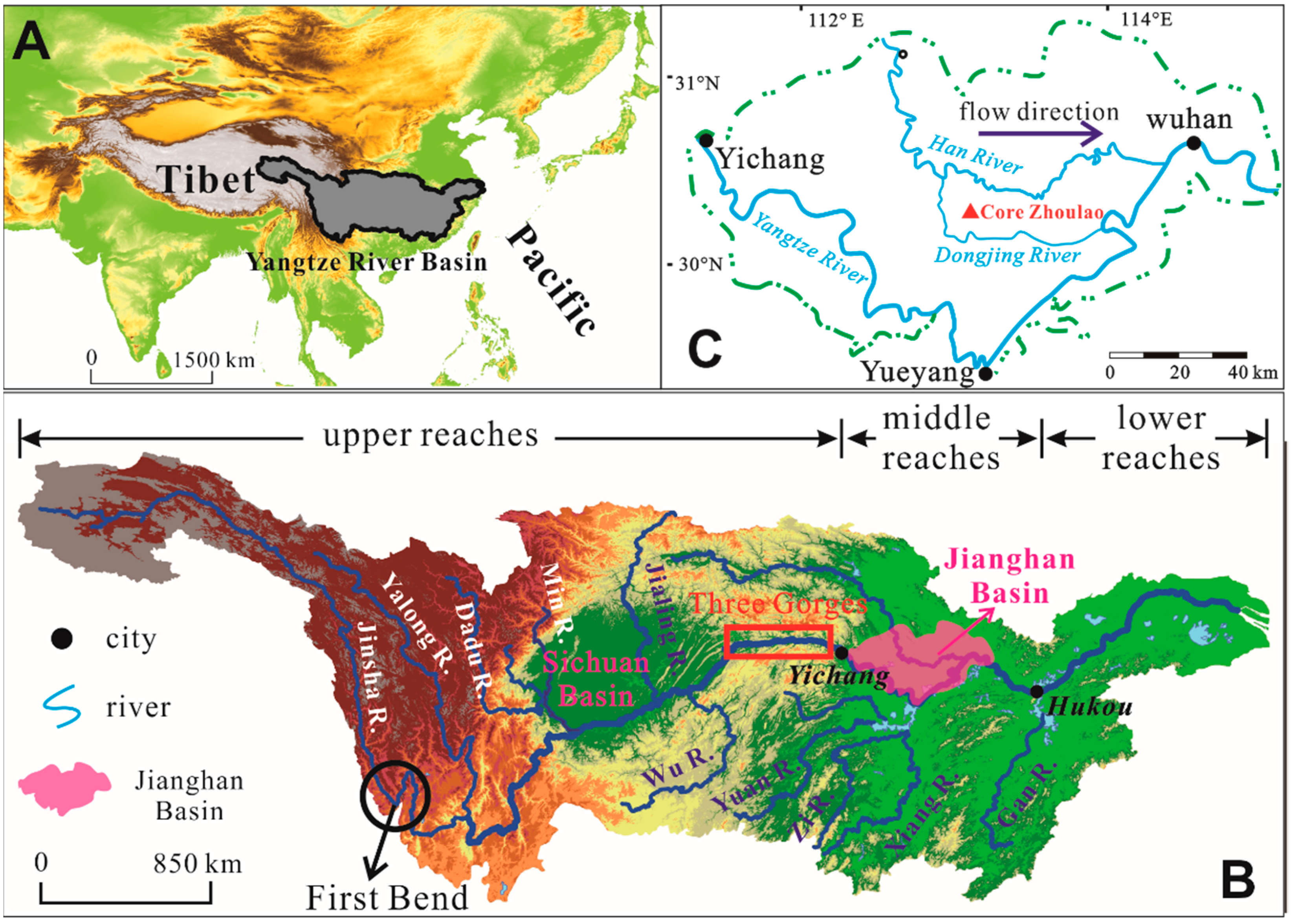
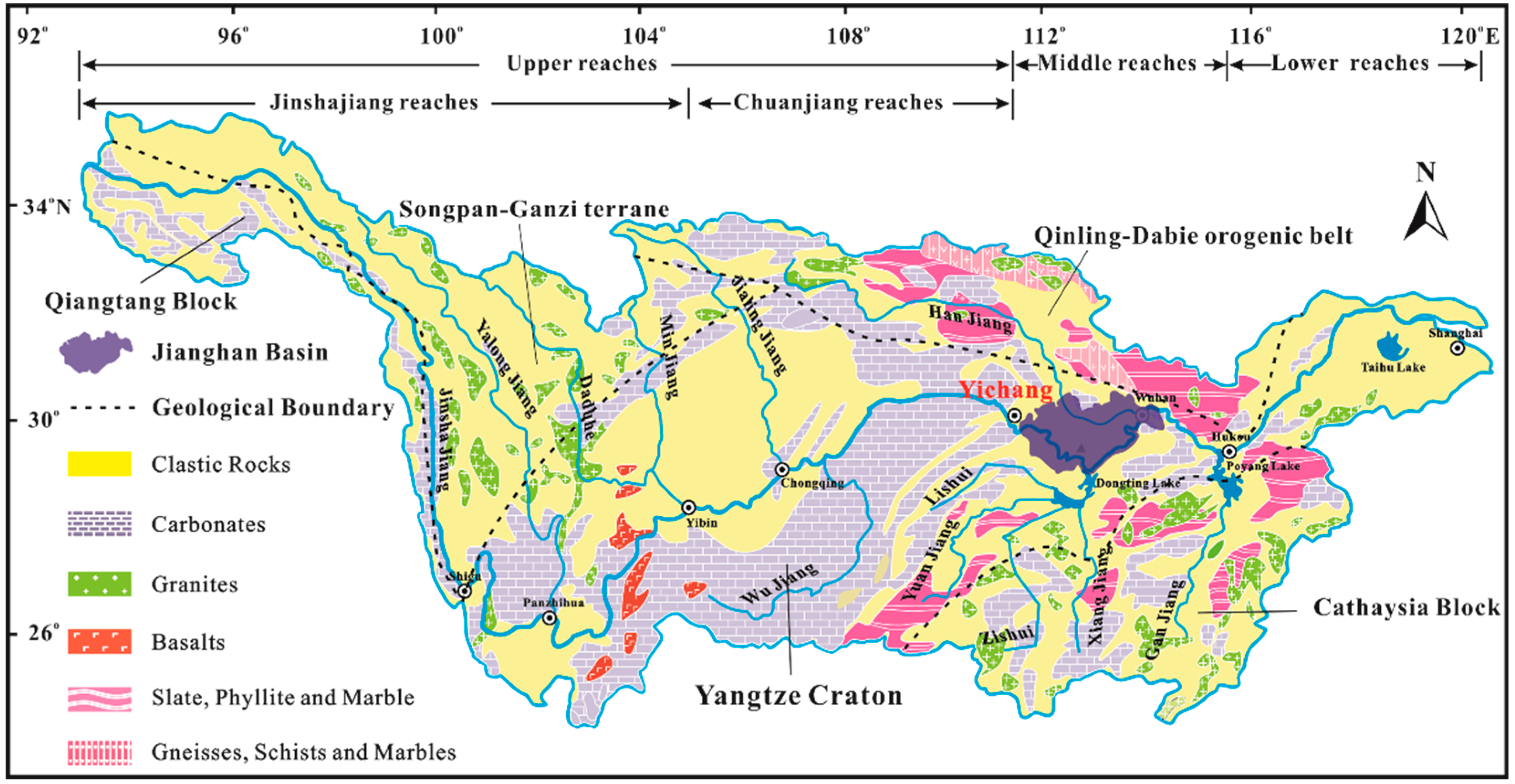
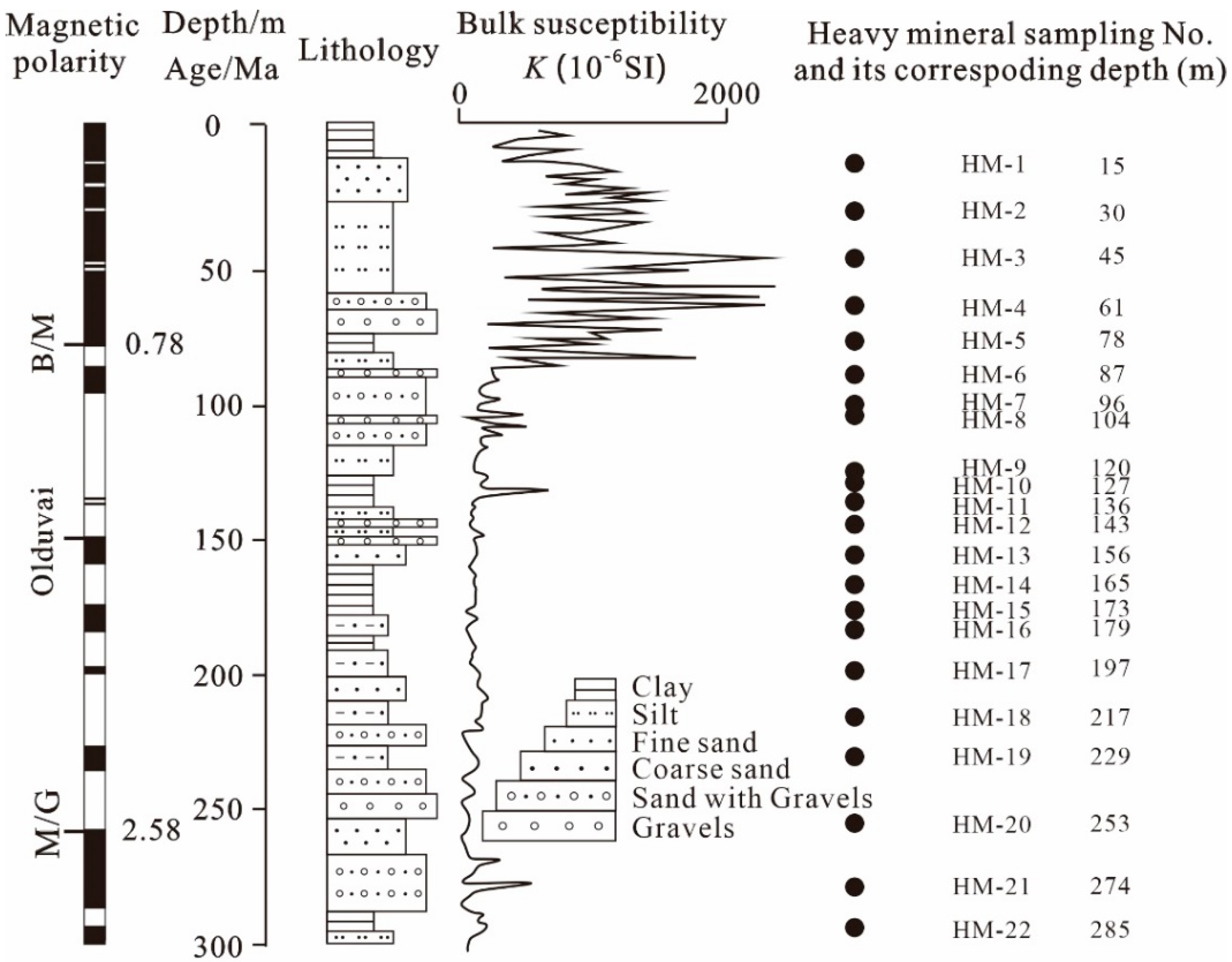
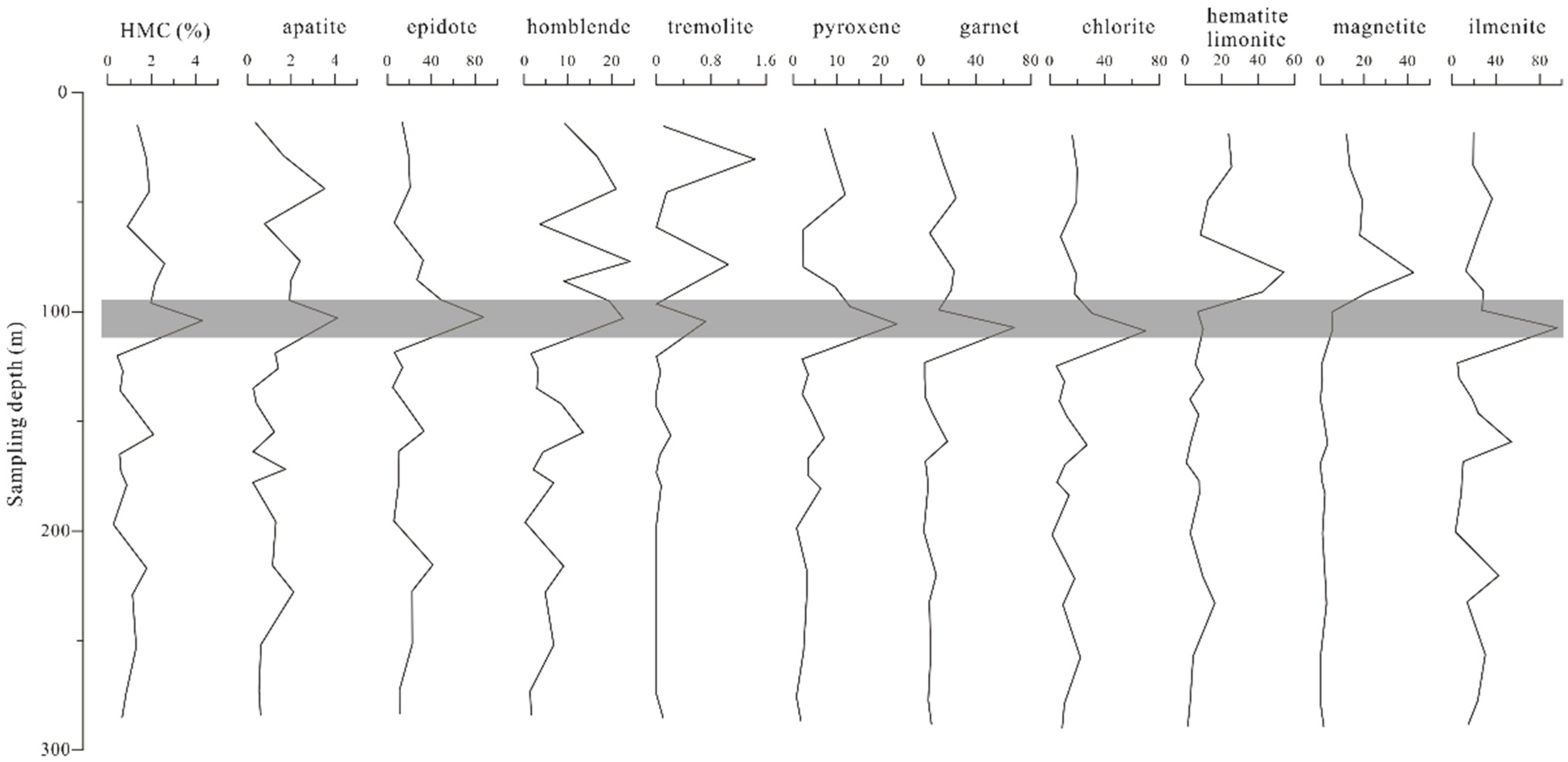
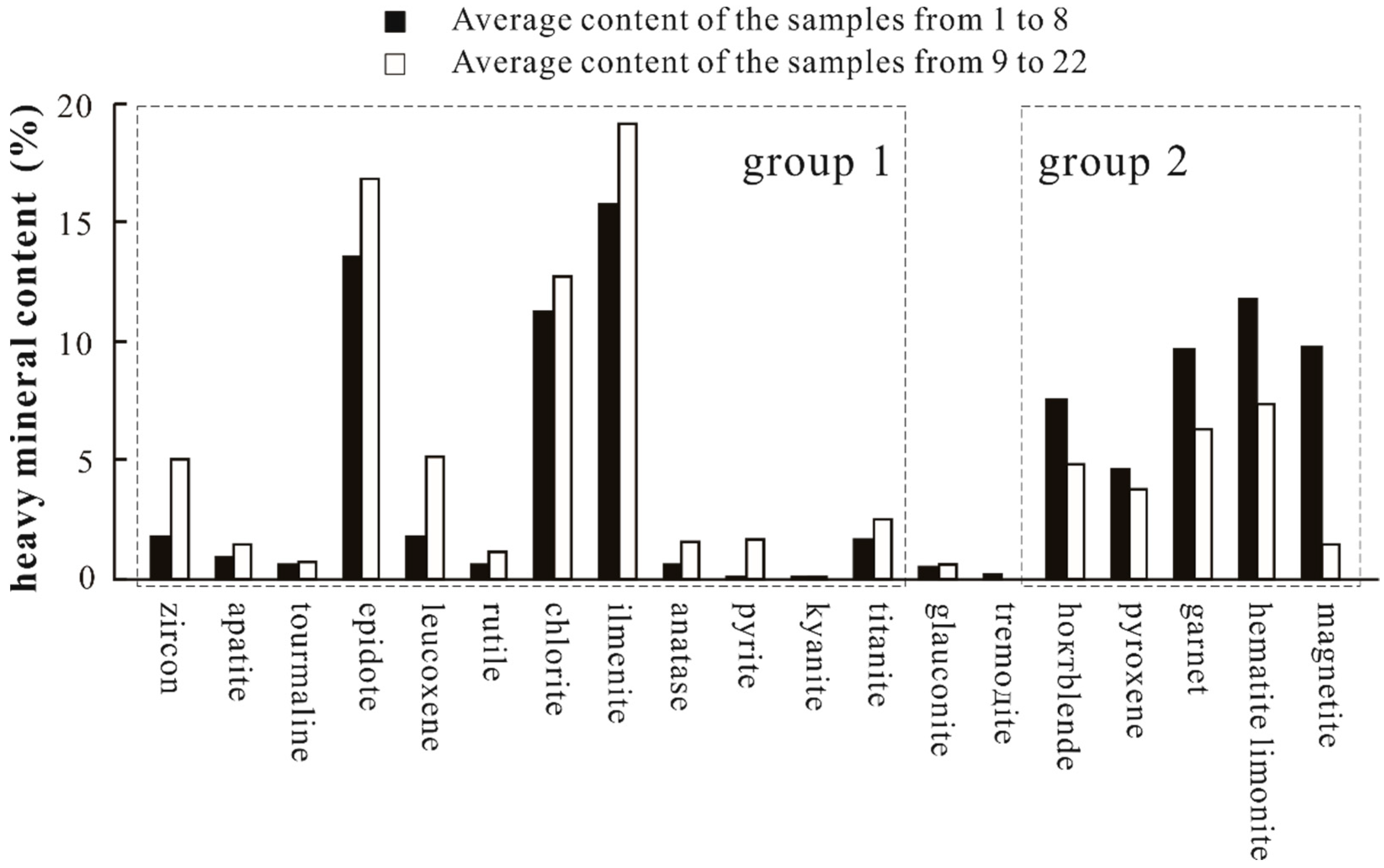
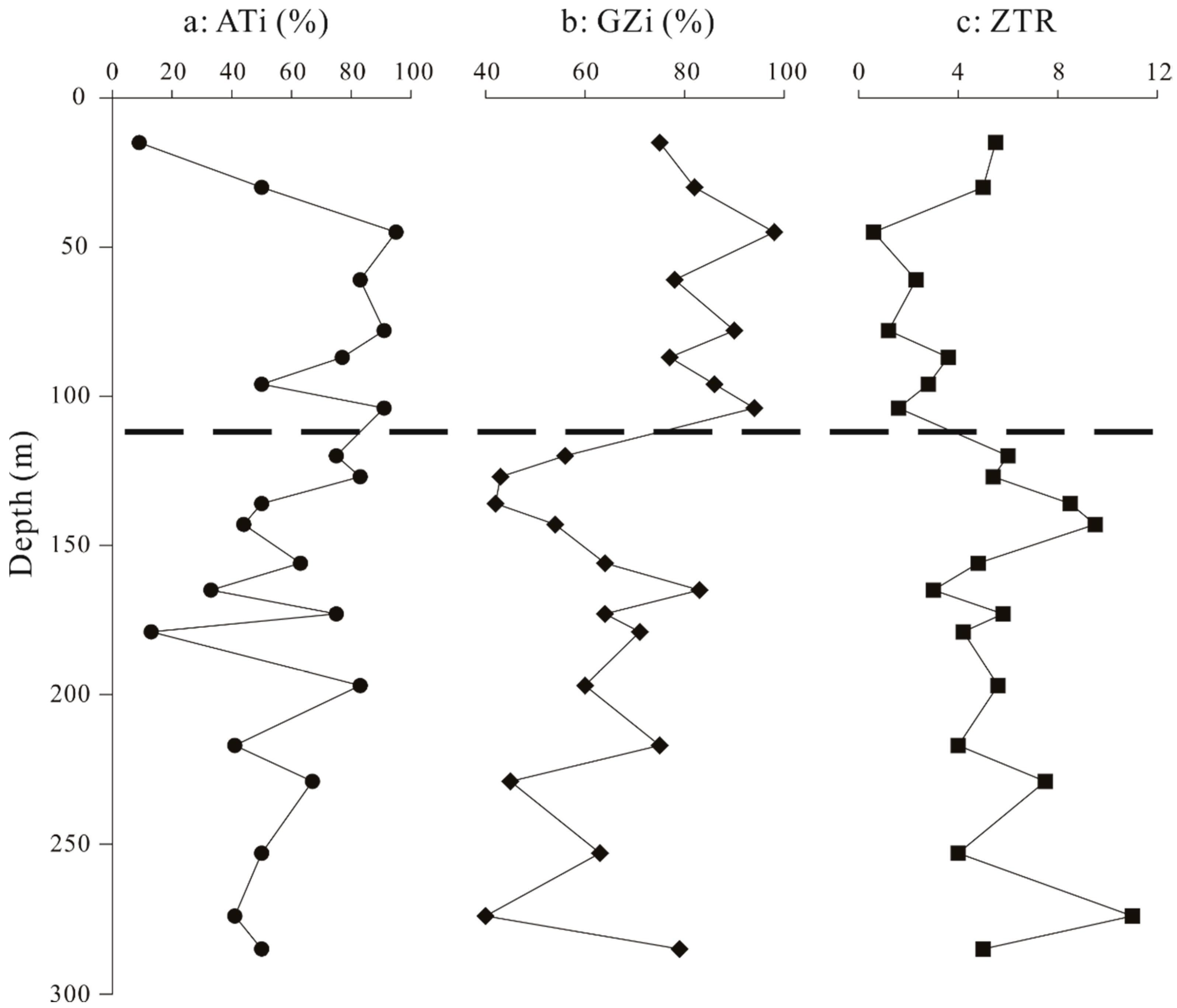
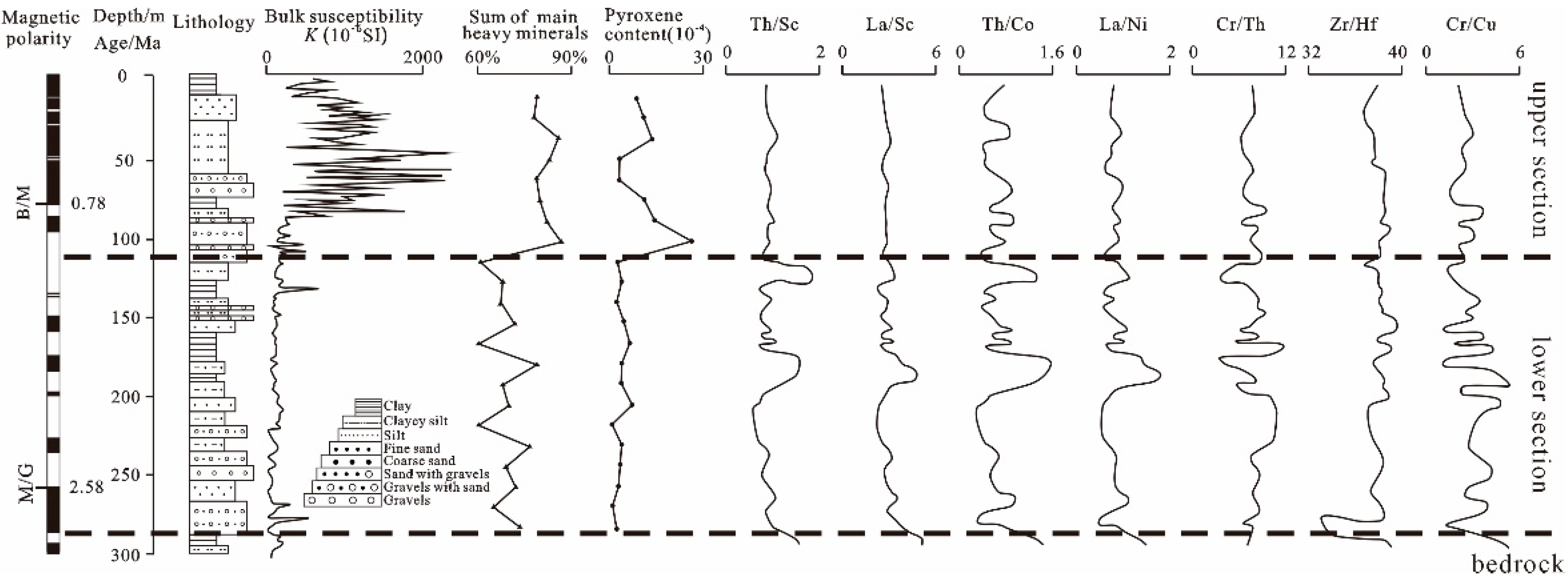
| Sample Number | Sampling Depth (m) | Total Weight of Sample (g) | Total Weight of Heavy Minerals (g) | % Content of Heavy Minerals | Zircon | Apatite | Tourmaline | Titanite | Kyanite | Epidote | Hornblende | Tremolite | Pyroxene | Garnet | Leucoxene | Rutile | Glauconite | Chlorite | Anatase | Pyrite | Hematite–Limonite | Ilmenite | Magnetite | Allanite | Debris Affected by Iron |
|---|---|---|---|---|---|---|---|---|---|---|---|---|---|---|---|---|---|---|---|---|---|---|---|---|---|
| 1 | 15 | 550 | 7.40 | 1.35 | 3.08 | 0.38 | 3.30 | 3.64 | 0.13 | 13.40 | 9.22 | 0.11 | 7.23 | 8.30 | 1.42 | 0.81 | 0.51 | 16.36 | 1.39 | 0.00 | 23.82 | 19.57 | 12.04 | 0.68 | 9.25 |
| 2 | 30 | 520 | 9.10 | 1.75 | 4.04 | 1.65 | 1.44 | 4.77 | 0.50 | 19.15 | 16.61 | 1.44 | 9.48 | 16.31 | 1.86 | 4.23 | 0.94 | 19.80 | 3.63 | 0.00 | 25.37 | 19.24 | 13.52 | 1.79 | 9.43 |
| 3 | 45 | 150 | 2.83 | 1.89 | 0.65 | 3.53 | 0.15 | 3.40 | 0.18 | 20.48 | 20.99 | 0.15 | 11.83 | 25.19 | 1.99 | 0.45 | 0.00 | 19.40 | 0.19 | few | 12.52 | 36.57 | 19.28 | 0.19 | 11.53 |
| 4 | 61 | 340 | 3.02 | 0.89 | 1.91 | 0.78 | 0.14 | 0.23 | 0.08 | 6.04 | 3.57 | 0.00 | 2.24 | 6.00 | 2.64 | 0.10 | 0.64 | 7.80 | 0.09 | 0.14 | 8.30 | 24.25 | 18.11 | 0.08 | 5.73 |
| 5 | 78 | 240 | 6.20 | 2.58 | 2.94 | 2.40 | 0.21 | 6.94 | 0.24 | 32.50 | 24.16 | 1.05 | 2.30 | 23.72 | 10.81 | 0.31 | 0.00 | 19.20 | 0.26 | 0.42 | 53.94 | 12.44 | 42.62 | 2.60 | 19.60 |
| 6 | 87 | 340 | 7.30 | 2.15 | 7.29 | 1.98 | 0.52 | 3.82 | 1.00 | 26.85 | 9.07 | 0.52 | 9.49 | 21.77 | 2.23 | 0.76 | 0.49 | 17.84 | 2.18 | few | 42.21 | 28.25 | 21.66 | 0.64 | 16.19 |
| 7 | 96 | 190 | 3.72 | 1.96 | 2.36 | 1.93 | 1.68 | 1.86 | few | 48.45 | 19.39 | few | 12.91 | 12.69 | 4.34 | 1.97 | 1.57 | 30.81 | 0.21 | 0.34 | 6.83 | 27.45 | 5.26 | 0.00 | 15.73 |
| 8 | 104 | 80 | 3.45 | 4.31 | 5.04 | 4.11 | 0.36 | 1.98 | few | 87.59 | 22.60 | 0.72 | 23.64 | 67.80 | 4.64 | 2.64 | 6.72 | 69.95 | 0.45 | 0.72 | 9.74 | 95.97 | 5.62 | 0.89 | 20.17 |
| 9 | 120 | 620 | 2.60 | 0.42 | 2.07 | 1.27 | 0.37 | 2.44 | few | 6.13 | 1.55 | 0.00 | 2.02 | 2.32 | 2.86 | 0.54 | 0.14 | 4.65 | 0.93 | 0.15 | 5.50 | 4.93 | 0.58 | 0.46 | 3.11 |
| 10 | 127 | 410 | 2.80 | 0.68 | 3.46 | 1.41 | 0.25 | 2.04 | 0.07 | 13.64 | 3.23 | 0.06 | 3.38 | 2.32 | 3.18 | 0.90 | 0.58 | 10.58 | 0.47 | 0.50 | 10.01 | 6.39 | 0.96 | 0.31 | 4.61 |
| 11 | 136 | 700 | 3.90 | 0.56 | 4.60 | 0.27 | 0.23 | 2.58 | 0.05 | 4.67 | 2.94 | few | 2.05 | 2.94 | 2.41 | 0.69 | 0.13 | 6.96 | 1.18 | few | 2.54 | 18.05 | 0.15 | 0.23 | 3.06 |
| 12 | 143 | 300 | 3.30 | 1.10 | 7.56 | 0.41 | 0.45 | 3.97 | few | 14.93 | 8.47 | few | 3.94 | 7.91 | 3.48 | 3.95 | 0.50 | 12.34 | 2.27 | few | 7.30 | 23.99 | 1.40 | 0.45 | 6.72 |
| 13 | 156 | 410 | 8.51 | 2.08 | 12.03 | 1.23 | 0.64 | 0.47 | 0.50 | 33.25 | 13.48 | 0.21 | 7.05 | 18.88 | 8.30 | 1.57 | 1.00 | 27.00 | 0.54 | 4.32 | 2.90 | 54.07 | 3.35 | 0.80 | 16.04 |
| 14 | 165 | 400 | 2.13 | 0.53 | 0.64 | 0.26 | 0.46 | 0.50 | few | 10.60 | 4.30 | 0.05 | 3.50 | 2.87 | 2.35 | 0.67 | 0.85 | 10.96 | 0.06 | 0.09 | 0.62 | 10.14 | 0.07 | few | 4.26 |
| 15 | 173 | 500 | 3.00 | 0.60 | 2.83 | 1.73 | 0.50 | 1.11 | 0.06 | 10.05 | 2.11 | few | 3.31 | 4.44 | 3.90 | 0.59 | 0.38 | 5.19 | 1.91 | 0.30 | 7.51 | 8.97 | 0.79 | 0.63 | 3.77 |
| 16 | 179 | 70 | 0.60 | 0.86 | 2.00 | 0.25 | 1.43 | 0.08 | 0.08 | 10.28 | 6.74 | 0.07 | 6.26 | 4.49 | 2.76 | 0.21 | 0.67 | 13.90 | 0.09 | 7.20 | 7.74 | 8.47 | 2.23 | 0.09 | 10.68 |
| 17 | 197 | 750 | 1.90 | 0.25 | 1.27 | 1.30 | 0.23 | 0.75 | 0.00 | 5.77 | 0.24 | 0.00 | 0.75 | 1.71 | 2.05 | 0.20 | 0.11 | 1.56 | 0.57 | 0.18 | 2.76 | 3.02 | 1.06 | 0.14 | 1.69 |
| 18 | 217 | 300 | 5.30 | 1.77 | 4.02 | 1.15 | 1.43 | 3.17 | few | 41.29 | 9.01 | few | 3.14 | 10.82 | 7.40 | 2.10 | 2.68 | 18.05 | 3.62 | 5.78 | 9.71 | 42.53 | 2.24 | 0.53 | 8.04 |
| 19 | 229 | 260 | 2.90 | 1.12 | 7.75 | 2.11 | 0.92 | 2.03 | 0.21 | 22.44 | 4.82 | few | 3.03 | 5.79 | 7.13 | 0.68 | 0.17 | 9.49 | 1.16 | 1.86 | 16.21 | 13.66 | 2.88 | 0.69 | 8.61 |
| 20 | 253 | 170 | 2.20 | 1.29 | 4.53 | 0.62 | 0.54 | 4.75 | few | 22.63 | 6.76 | few | 2.36 | 6.76 | 8.32 | 0.79 | 1.01 | 22.20 | 2.71 | 0.22 | 4.37 | 30.31 | 0.17 | 0.40 | 10.06 |
| 21 | 274 | 290 | 2.40 | 0.83 | 8.32 | 0.53 | 0.66 | 3.64 | few | 10.94 | 1.38 | few | 0.72 | 4.97 | 5.10 | 0.97 | 0.12 | 10.56 | 2.49 | 1.06 | 2.68 | 23.45 | 0.10 | 0.16 | 4.93 |
| 22 | 285 | 310 | 2.01 | 0.65 | 2.20 | 0.60 | 0.52 | 0.58 | 0.06 | 11.00 | 1.64 | 0.10 | 1.72 | 7.23 | 2.70 | 0.77 | 0.49 | 8.97 | 0.33 | 3.16 | 1.42 | 14.73 | 1.63 | 0.13 | 4.89 |
| Sample No. | ATi | GZi | ZTR | Sample No. | ATi | GZi | ZTR |
|---|---|---|---|---|---|---|---|
| 1 | 9 | 75 | 5.5 | 12 | 44 | 54 | 9.5 |
| 2 | 50 | 82 | 5.0 | 13 | 63 | 64 | 4.8 |
| 3 | 95 | 98 | 0.6 | 14 | 33 | 83 | 3.0 |
| 4 | 83 | 78 | 2.3 | 15 | 75 | 64 | 5.8 |
| 5 | 91 | 90 | 1.2 | 16 | 13 | 71 | 4.2 |
| 6 | 77 | 77 | 3.6 | 17 | 83 | 60 | 5.6 |
| 7 | 50 | 86 | 2.8 | 18 | 41 | 75 | 4.0 |
| 8 | 91 | 94 | 1.6 | 19 | 67 | 45 | 7.5 |
| 9 | 75 | 56 | 6.0 | 20 | 50 | 63 | 4.0 |
| 10 | 83 | 43 | 5.4 | 21 | 41 | 40 | 11.0 |
| 11 | 50 | 42 | 8.5 | 22 | 50 | 79 | 5.0 |
Publisher’s Note: MDPI stays neutral with regard to jurisdictional claims in published maps and institutional affiliations. |
© 2021 by the authors. Licensee MDPI, Basel, Switzerland. This article is an open access article distributed under the terms and conditions of the Creative Commons Attribution (CC BY) license (https://creativecommons.org/licenses/by/4.0/).
Share and Cite
Kang, C.; Li, C.; Wei, C.; Zhang, Y.; Jiang, H.; Li, Y.; Guo, R. Heavy Mineral Assemblage Variation in Late Cenozoic Sediments from the Middle Yangtze River Basin: Insights into Basin Sediment Provenance and Evolution of the Three Gorges Valley. Minerals 2021, 11, 1056. https://doi.org/10.3390/min11101056
Kang C, Li C, Wei C, Zhang Y, Jiang H, Li Y, Guo R. Heavy Mineral Assemblage Variation in Late Cenozoic Sediments from the Middle Yangtze River Basin: Insights into Basin Sediment Provenance and Evolution of the Three Gorges Valley. Minerals. 2021; 11(10):1056. https://doi.org/10.3390/min11101056
Chicago/Turabian StyleKang, Chunguo, Chang’an Li, Chuanyi Wei, Yufen Zhang, Huajun Jiang, Yawei Li, and Rujun Guo. 2021. "Heavy Mineral Assemblage Variation in Late Cenozoic Sediments from the Middle Yangtze River Basin: Insights into Basin Sediment Provenance and Evolution of the Three Gorges Valley" Minerals 11, no. 10: 1056. https://doi.org/10.3390/min11101056
APA StyleKang, C., Li, C., Wei, C., Zhang, Y., Jiang, H., Li, Y., & Guo, R. (2021). Heavy Mineral Assemblage Variation in Late Cenozoic Sediments from the Middle Yangtze River Basin: Insights into Basin Sediment Provenance and Evolution of the Three Gorges Valley. Minerals, 11(10), 1056. https://doi.org/10.3390/min11101056






